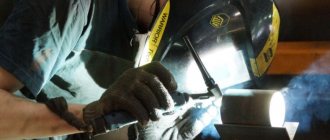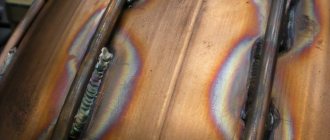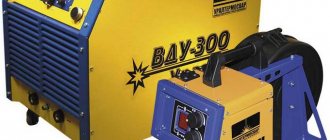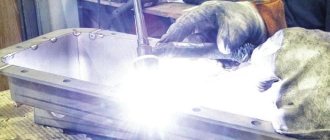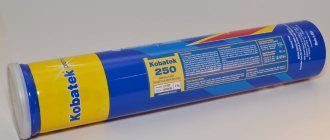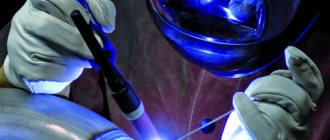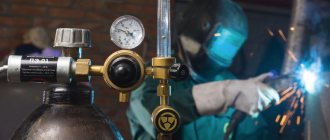Aluminum DC Welding
There are several welding methods, which depend not only on the technique used, but also on the modes that the user sets.
If we consider the use of electric welding, then several options may arise, which depend on the type of current. Aluminum DC welding is just one of these types. It is not used as often as alternating current, but still has a number of features that are determined by polarity. Masters prefer alternating electricity, as it combines the advantages of both polarities. Welding aluminum with direct current, reverse polarity
When welding aluminum with direct current, you have to choose what is more important for the welding process. After all, the welding properties of aluminum are far from the best, therefore, it is necessary to select suitable conditions that could satisfy the technological requirements and ensure an even and tight aluminum weld. The main problem with this formation is the oxide film, which the high welding temperature cannot cope with, since it melts at 2200 degrees Celsius, and aluminum at 680. The reverse polarity of the direct current helps to destroy it thanks to cathode sputtering, which works well in combination with fluxes and pre-processing.
Welding aluminum with argon DC
Features and importance of preparing the parts to be joined for welding
The quality of the connection depends on the thorough preparation of the base before performing work. It should be remembered that the melting point of the oxide film that covers the surface is higher than that of pure metal. The presence of aluminum oxide in the melt zone leads to a decrease in the quality of the weld.
The surface preparation process includes the following work:
- Degreasing the connection area using a solvent;
- Removing the oxide film mechanically or chemically;
Mechanical surface treatment with improvised means is used when performing work at home. In industrial production sites, they usually resort to a chemical method - etching the surface with special compounds, which eliminates the possibility of foreign particles entering the melt zone.
Flaws
- You have to choose between a stable arc or destruction of oxides;
- Without destroying the oxide film, it is impossible to achieve high quality welding, since it envelops the molten metal, preventing it from joining normally;
- It is difficult to select equipment parameters for welding a specific thickness of metal in this operating mode.
Nuances when welding with direct current
Before welding aluminum using electric welding, you first need to understand the equipment parameters. Experts do not recommend using direct current of direct polarity, since its disadvantages outweigh its advantages and welding aluminum with an electrode with it turns out to be very problematic. Reverse polarity overcomes one of the main problems with aluminum weldability, but it is not the only problem encountered.
Other nuances of this process include the high fluidity of the metal in the molten state, which cannot be overcome by any kind of current, but only by the skill of the welder. It is also worth considering the increased susceptibility to voltage, which involves heating the metal and thoroughly drying the electrodes before use. Here it is necessary to take into account the low depth of metal penetration, so when working with thick workpieces, additional edge processing may be required. In terms of preliminary preparation, there are also several nuances that relate to cleaning the surface with solvents and simple mechanical methods, which should increase the quality of the connection.
Which filler wire to choose
For AC TIG welding, the industry produces standard rods designed only for aluminum. Their appearance is shown in the photo below:
They are produced in various diameters and are selected depending on the thickness of the metal and the current welding mode. The indicative table will help in choosing the right solder.
Table 1
Universal ER 4043 - for welding aluminum and its alloys AD31, AD33, AD35 with magnesium, silicon and other elements. Types of industrial solders for TIG aluminum welding are determined by GOST 7871-75. The most common:
- AL ER5356 - for AlMg4, AlMg3, AlMg5, AlMg6 alloys.
Both the quality and speed of welding depend on the choice of solder, which is important - the TIG welding process is several times slower than MMA or MIG, so the possibility of speeding it up is very relevant.
TIG aluminum welding
Many experts note the poor weldability of aluminum, so to obtain a strong connection, special methods are used that help achieve high-quality results. TIG welding of aluminum is one of these methods, since it helps to combat the main negative factors that create problems during welding. Here everything is carried out under the protection of an inert gas, which is most often argon. But the main force that melts the metal here is the electric arc, which is formed between the metal of the workpiece and the infusible electrode.
Application
The advantages of TIG welding of metals find its application in the following industries:
- mechanical and instrument engineering;
- food production;
- oil industry;
- chemical industry;
- drilling rigs;
- construction of metal structures for high-rise buildings;
- steel frame structures;
- pipelines;
- aviation;
- astronautics;
- aircraft manufacturing;
- shipbuilding.
Argon TIG welding is also used for less global solutions. It is often used in domestic conditions. An example is installing an air conditioner in a car or repairing cracks in a car radiator. In all homes there are kitchen utensils and metal towel rails made using this method.
TIG argon welding has become so widespread due to the fact that it can be used to weld both carbon steel and non-ferrous metals, while maintaining excellent weld quality.
Advantages
- Inert gas is the best protective medium at the moment, which creates conditions impenetrable to oxygen and hydrogen;
- There is no risk of moisture getting into the weld pool from the electrode coating;
- The arc has high combustion stability;
- The seams are more neat and thin, and the welding joints are stronger;
- Many of the disadvantages of aluminum weldability become less significant;
- Ability to work with a wide range of settings modes.
Advantages and disadvantages of welding in argon environment
The advantages of argon arc welding include:
- Reliable protection of the weld pool;
- Possibility of joining dissimilar metals;
- Visual control of seam quality;
- Accuracy of work execution;
- Welding is carried out in all spatial positions.
Along with the advantages, there are a number of disadvantages:
- Qualification requirements for a welder;
- The need to purchase expensive equipment;
- Low work productivity.
Flaws
- High cost of the welding process;
- When working with gas, work becomes less safe;
- Gas combustion is harmful to the health of the welder;
- TIG welding of aluminum has a longer preparation process and, accordingly, becomes more labor-intensive.
Why is alternating current important?
Recently, TIG welding of aluminum with direct current is practically not carried out, since most specialists use alternating current. There are several specific provisions that predispose to the choice of this particular type of electricity. When direct current is connected at reverse polarity, cathodic cleaning of the oxide film is created. At the same time, the welding temperature increases significantly. For this reason, destruction of the tungsten electrode, which is actively used in this area, may occur. By connecting direct current with straight polarity, it will not be able to eliminate the oxide film, so even with a more stable arc there will be poor welding quality. Thus, switching the polarity can provide a high quality result and that is why it is worth choosing alternating current. TIG welding of aluminum with a DC inverter is carried out very rarely, since it turns out to be too difficult to operate.
What is needed for TIG welding
In order to carry out the welding process, the following set of equipment is required:
- Tungsten electrodes of various diameters;
- Grounding for the device;
- Welding inverter TIG (DC/AC);
- Consumable filler material, in the form of welding wire;
- Torch for this type of welding;
- Gas hoses;
- Cylinder with inert gas;
- Nozzles for the burner and collet with holder;
- Burner cooling unit;
- Reducer for adjusting gas pressure.
Basic welding method
Argon arc welding of aluminum and its alloys (AC TIG) is carried out using alternating current, the source of which, as a rule, is an inverter generator. The inverter not only produces a very precise sine wave current, which is important when welding, but is also very compact. In addition to the inverter itself, the device includes:
- gas cylinder (argon or argon + helium);
- TIG torch;
- gas hoses;
- cables.
The AC TIG machine operates using tungsten non-consumable electrodes and filler wire. The standard welder’s kit also includes a shield (preferably “Chameleon” and protective leggings). The device provides adjustment of welding current and gas flow. But welding modes will be discussed below.
Safety regulations
When welding, we must not forget about safety rules. It is necessary to use protective equipment for the welder: a mask or shield, gloves or leggings, special clothing and shoes.
All masks can be divided into active and passive. The sight glass of passive masks is permanently darkened. In active ones, darkening occurs only as a reaction to a light flash from the arc. The advantage of this option is that while the welding process is stopped, the glass becomes transparent and the welder can clearly see the object. There is no need to lift the glass, which is quite convenient.
Main types of welding gaiters:
- Canvas . They are not in demand because they do not perform well the main function of protecting hands from high temperatures and sparks. They easily burn when exposed to sparks.
- Split fibers . Made from specially treated leather from pigs or cows. Resistant to flying sparks. Durable, elastic, hygienic. Does not restrict hand movements. If there is a cotton layer inside, it keeps your hands warm.
- Felt . Convenient for welding work.
There are combined models that use different types of materials. Welding gaiters come in length up to the elbow and cover only the hand. The possibility of tightening the edge of the glove provides additional safety.
A welder's suit must be made of high quality materials. It must be resistant to splashes of molten metal. The requirements for a welder's suit are specified in GOST 12.4.250. The main parts of the suit are the jacket and trousers. The material from which they are made must have great heat resistance. According to the regulatory material, the jacket must cover the trousers by more than 20 cm. The fasteners are closed with flaps. The maximum distance between them on the jacket is 15 cm.
Safety regulations include electrical safety. The argon cylinder must be located at a distance of at least 5 meters from possible sources of fire. The cylinder must be placed vertically and secured to prevent it from falling. Before work, it is necessary to check the condition of the hoses.
